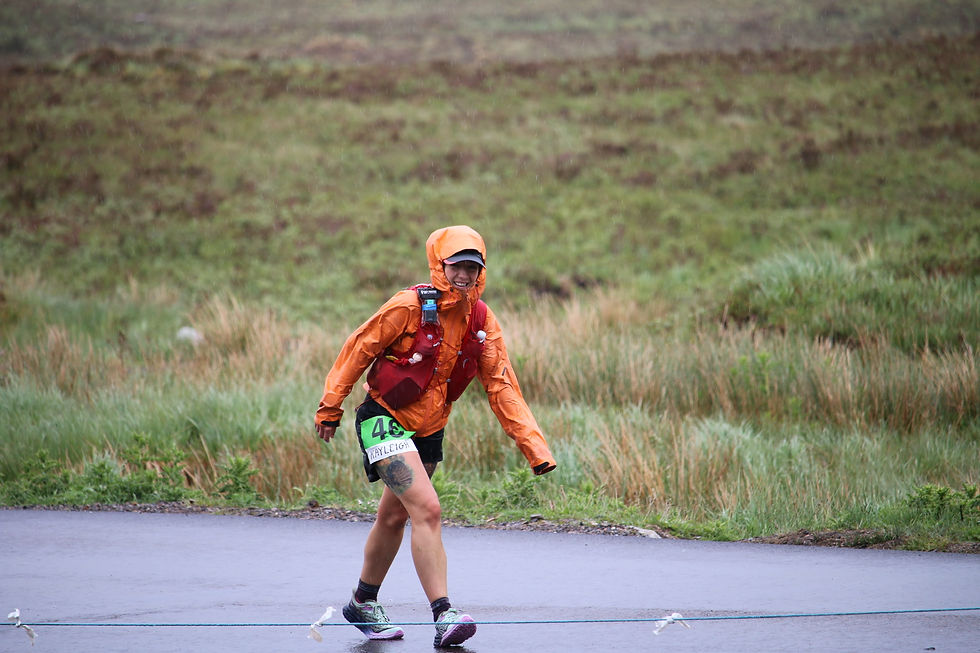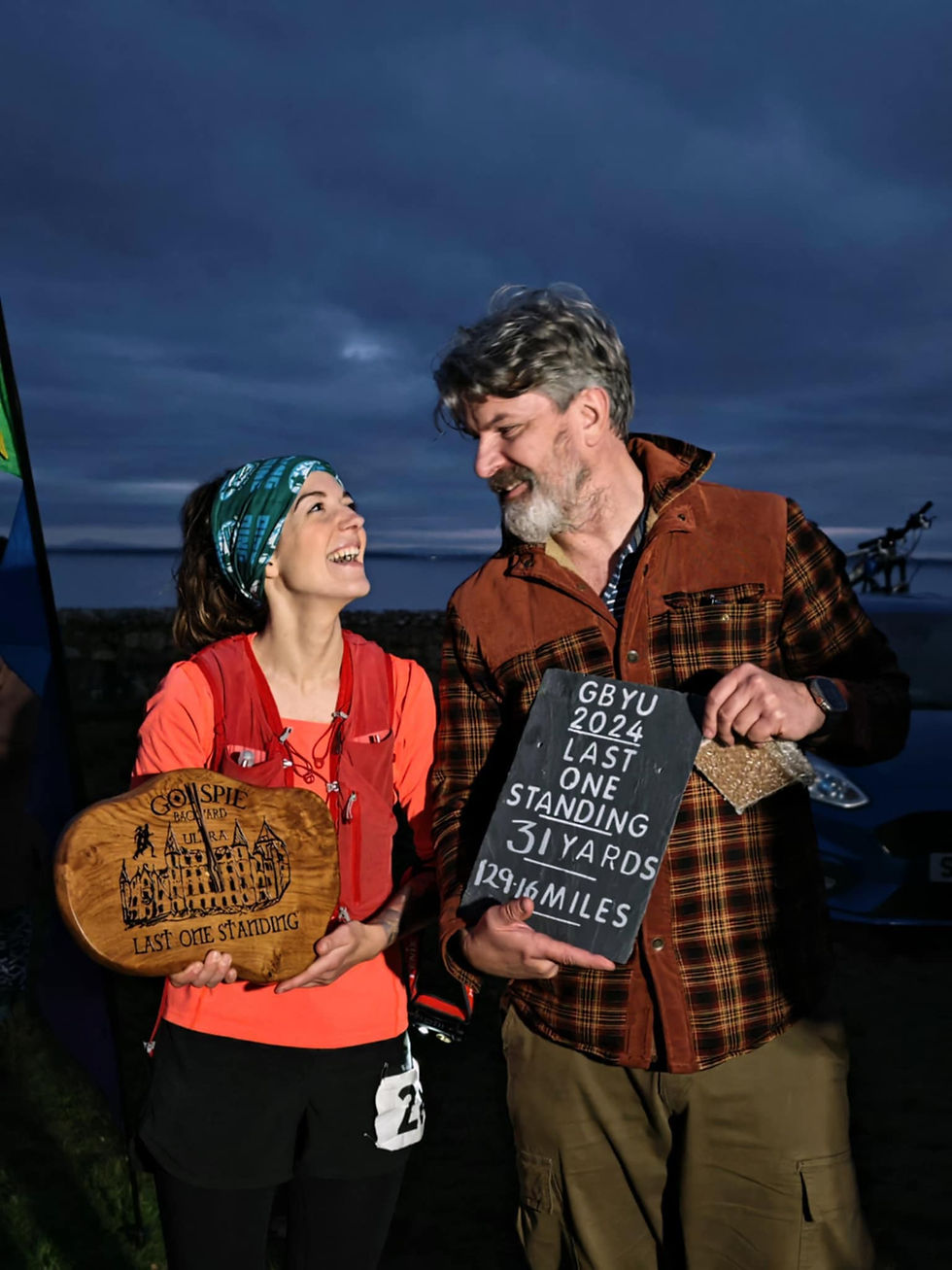West Highland Way Race: My First DNF
- Kayleigh Webster
- Jun 4
- 6 min read
Updated: Jun 24
DNF. Three letters I’ve never had to use before – and I’m choosing to see them not as “Did Not Finish” but “Did Nothing Foolish.” Because as gutted as I am, I know I made the right call.

Race day started brilliantly. The first couple of hours were actually warm and surprisingly sunny — not quite what you’d expect from the Scottish Highlands. My kit was dialled, my nutrition plan was spot on, and mentally, I felt calm – maybe even quietly hopeful. I knew the hip had been niggly for a while, but I’d had runs where it felt fine, and there was part of me that wondered (hoped?) if this would be one of those magic days where everything just clicks.

And for a while, it did.
The first two hours passed with company, and the trail chatter that makes these events feel so special. I got chatting to a mix of people, including one guy who had travelled all the way from Canada for the race. I never caught his name, but I really hope he finished.
Then a chap called Ronnie overheard I was from West Lothian, and we got chatting about people we both knew. He asked if I'd be running the Beecraigs Backyard Ultra, and the joy I got from seeing his face when I told him it was my event — that was a highlight in itself. He was a good laugh, and mid-conversation he managed an epic faceplant followed by an army roll that set off his Garmin fall alert. Only five miles in, bloodied face and knee, but he took it like a champ. His biggest worry? That he’d lost the start of the race on his watch and had to reset it. Classic ultra runner priorities.

After leaving Lundavra, I found myself on my own for an hour. That’s when the hip really started to bother me. I caught my right foot on something and almost had a full-speed fall but caught myself just in time. The jolt sent an agonising shockwave through my left hip. I pulled out my phone, ready to message Michael to say I was dropping at Kinlochleven.
No signal.
So I sucked it up and carried on. I found this weirdly effective John Wayne-style waddle-run that seemed to ease the pain. It even felt efficient enough that I started catching runners again. Hope crept back in. Maybe I could get through this?
Then came the descent into Kinlochleven. I stubbed my foot again, and the pain returned. Only three hours in. I genuinely thought: how am I supposed to go for another twenty-plus hours if this is how it feels already?
It wouldn’t be a proper ultra in Scotland without a dramatic shift in weather. As I got into Kinlochleven, the heavens opened and we were treated to that signature soaking rain — the kind that clings to you no matter what you’re wearing. A good test for the foot care plan, if nothing else.

I saw Michael and told him I was still optimistic. I took paracetamol and headed back out, saying I'd reassess between here and Glencoe. With my waddle still in action, I was back on the trail.
That’s when Mark approached me and asked if I was OK — he’d noticed the limp. He stuck with me all the way to the summit of the Devil’s Staircase, chatting and keeping spirits high. Casual chat included how he'd summited Ben Nevis for breakfast. As you do. I took the descent with more caution and Mark took off, but I was still moving OK. The hip was achy but not awful.
I really love this section too. It’s open and dramatic and humbling. I passed a few runners, eventually caught up with Elliot, and had a great chat before waddling ahead into Glencoe.

I felt utterly sodden. My jacket was brilliant — Goretex and typically bulletproof — but there's no jacket yet invented that can fend off that kind of Scottish rain. I changed into dry clothes and socks, and told Michael I was feeling good. "I think I can manage this now," I said.
Oh, how the optimism faded.
Not long after heading across Rannoch Moor, the pain came back. Worsened, even. My waddle wasn’t helping, and paracetamol had no effect. This was it. Decision time.
Michael wasn’t due to meet me until Tyndrum, but I knew that was too far. I messaged him and said I was going to get to Bridge of Orchy, and that would be it.
He was brilliant. So were the friends who messaged around then, asking if I was sure, making sure I wouldn't regret it, but trusting me to make the right call. They were there for me in exactly the way I needed.

And as soon as I said it out loud, I felt this wave of emotion. I got teary. But it wasn’t sadness.
It was pride.
The same pride I felt in the final miles of my first marathon.
So I stopped at Bridge of Orchy.
Not because I wasn’t strong enough. But because I was. Strong enough to say: this isn’t my race to finish today.
It’s easy to write about triumphs. But this – this kind of decision – is where the growth really is. I’m proud. And I’ve got no regrets.
Hip Injury and Diagnosis After the DNF
I’d had a few warning signs in the lead-up. A hip ache that came and went, a niggle that didn’t escalate, but didn’t fade either. I even joked that a big long run would sort it. (Spoiler: it didn’t.)
After the race, things worsened. I was limping heavily, unable to lift my knee without pain, and had a real pinch deep in the groin. I tried to be sensible – so I did what any reasonable person would do... I asked DrGPT, and it had some worrying thoughts. To be sure, I called NHS24 and they suspected it was a fracture and I should go to A&E.

After 5 hours of waiting in one of the most interesting places to be in West Lothian on a Sunday night, at 3am, I finally got an X-ray which showed no obvious fracture but I was also told that this typically happens and an MRI is what is needed. With the waiting list for an MRI stretching into months, I went private. Within 90 minutes, I had a full consultation, X-ray, MRI, and diagnosis.
It was a stress fracture in the femoral neck.
The good news? Not a full break, no surgery required. But I’m now on crutches for 4 weeks and rebuilding from the ground up.
Post-Diagnosis Recovery and Mental Shift
Well, Team Scotland at the Highlander Backyard Ultra in July is out. I’ll still be there – as crew and support – and I’m proud of that, and so excited to put my energy into supporting others reach incredible goals and find strength they never knew they had. Race Across Scotland in August? Probably not the right idea for my first 200-miler. But I’ll be back. And I’ll be stronger.
There’s something freeing about stepping back and deciding to do this properly. To respect the recovery. I’ve got no interest in dragging myself to a start line just to tick a box or prove I can still show up. I want to feel strong. I want to feel prepared. And that means doing the work differently now — not less, but smarter.

I’ve got a renewed focus on strength training, especially heavy lifting, and especially for female athletes. For those of us moving into age categories we never thought we’d be in (hello, 35–39), the research is clear — it matters. Lifting heavy isn’t just about performance, it’s about resilience, bone density, injury prevention, and longevity in the sport. I’ll be writing more about that soon, because it’s something I think we don’t talk about enough, especially in ultra running circles.
Alongside that, I’m revisiting my nutrition. I don’t eat dairy, so I’ve started supplementing with calcium and vitamin D to support my recovery and long-term bone health. It sounds obvious, but I’m realising now how much these basics matter — especially after finding out I had a stress fracture and learning more about how it develops.
Navigating Injury With Positivity and Perspective
This whole thing has been a sharp reminder that your body doesn’t owe you anything, even when you feel like you’ve ticked all the boxes. But it’s also shown me where the gaps were – strength, rest, recovery, maybe even mindset. I’m not rushing to the next start line just to prove a point. I want to do things properly. So I’ll keep showing up for the process, one smart decision at a time, slowing down now, so I can keep going for years to come.


Comments